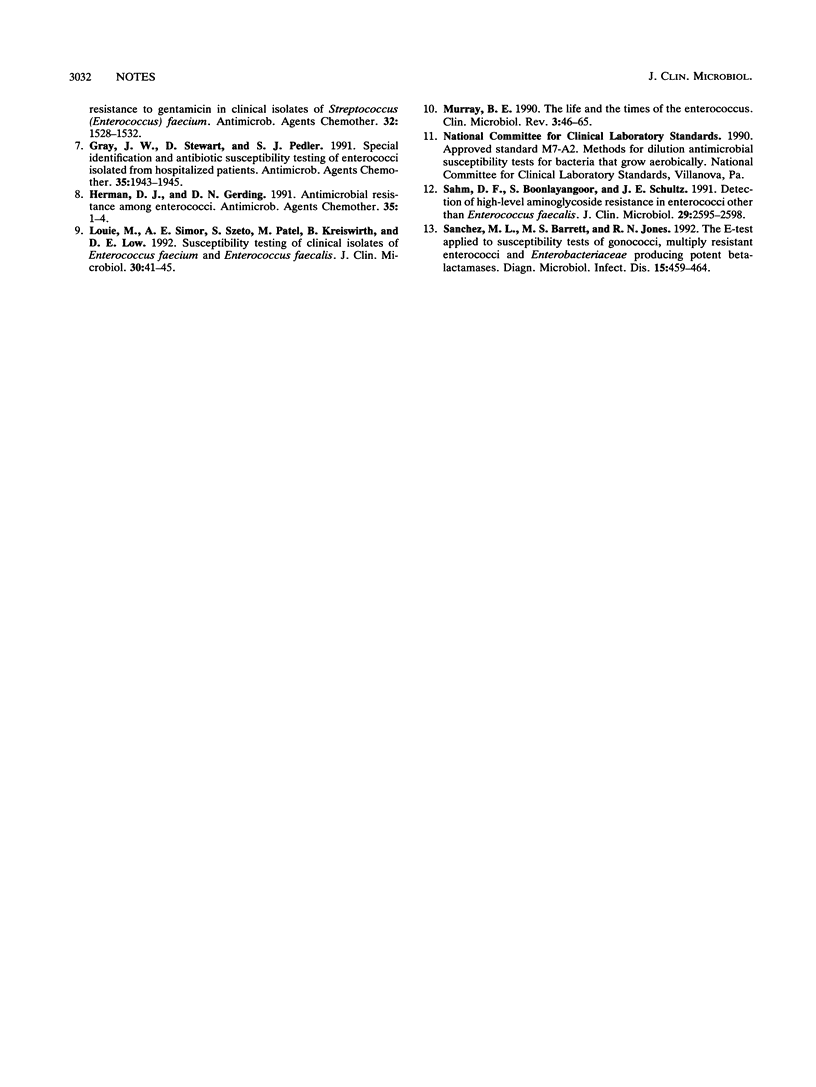Abstract
The E test and the reference agar dilution methods were compared for detecting high-level aminoglycoside resistance (HLAR) among 71 selected clinical isolates, including 62 Enterococcus faecalis and 9 Enterococcus faecium isolates. High-level gentamicin resistance alone was found in 11% (5 E. faecalis and 3 E. faecium strains) and high-level streptomycin resistance was found in 42% (28 E. faecalis, 2 E. faecium strains) of the strains tested, and 31% of the strains demonstrated high-level resistance to both antimicrobial agents (21 E. faecalis and 1 E. faecium strains). The E test detected all HLAR populations, but the streptomycin strip may require recalibration to achieve absolute MIC comparisons with the reference value (twofold less) or the use of an alternative interpretive resistance breakpoint, e.g., > 1,000 micrograms/ml. By the E test, MIC results indicate that ampicillin, imipenem, penicillin, piperacillin, and vancomycin remain active against the HLAR E. faecalis isolates; however, these tested drugs were less effective on the HLAR E. faecium isolates (< 50%).
Full text
PDF


Selected References
These references are in PubMed. This may not be the complete list of references from this article.
- Bryce E. A., Zemcov S. J., Clarke A. M. Species identification and antibiotic resistance patterns of the enterococci. Eur J Clin Microbiol Infect Dis. 1991 Sep;10(9):745–747. doi: 10.1007/BF01972500. [DOI] [PubMed] [Google Scholar]
- Eliopoulos G. M., Eliopoulos C. T. Therapy of enterococcal infections. Eur J Clin Microbiol Infect Dis. 1990 Feb;9(2):118–126. doi: 10.1007/BF01963636. [DOI] [PubMed] [Google Scholar]
- Gray J. W., Stewart D., Pedler S. J. Species identification and antibiotic susceptibility testing of enterococci isolated from hospitalized patients. Antimicrob Agents Chemother. 1991 Sep;35(9):1943–1945. doi: 10.1128/aac.35.9.1943. [DOI] [PMC free article] [PubMed] [Google Scholar]
- Herman D. J., Gerding D. N. Antimicrobial resistance among enterococci. Antimicrob Agents Chemother. 1991 Jan;35(1):1–4. doi: 10.1128/aac.35.1.1. [DOI] [PMC free article] [PubMed] [Google Scholar]
- Louie M., Simor A. E., Szeto S., Patel M., Kreiswirth B., Low D. E. Susceptibility testing of clinical isolates of Enterococcus faecium and Enterococcus faecalis. J Clin Microbiol. 1992 Jan;30(1):41–45. doi: 10.1128/jcm.30.1.41-45.1992. [DOI] [PMC free article] [PubMed] [Google Scholar]
- Murray B. E. The life and times of the Enterococcus. Clin Microbiol Rev. 1990 Jan;3(1):46–65. doi: 10.1128/cmr.3.1.46. [DOI] [PMC free article] [PubMed] [Google Scholar]
- Sahm D. F., Boonlayangoor S., Schulz J. E. Detection of high-level aminoglycoside resistance in enterococci other than Enterococcus faecalis. J Clin Microbiol. 1991 Nov;29(11):2595–2598. doi: 10.1128/jcm.29.11.2595-2598.1991. [DOI] [PMC free article] [PubMed] [Google Scholar]
- Sanchez M. L., Barrett M. S., Jones R. N. The E-Test applied to susceptibility tests of gonococci, multiply-resistant enterococci, and Enterobacteriaceae producing potent beta-lactamases. Diagn Microbiol Infect Dis. 1992 Jul;15(5):459–463. doi: 10.1016/0732-8893(92)90090-g. [DOI] [PubMed] [Google Scholar]


